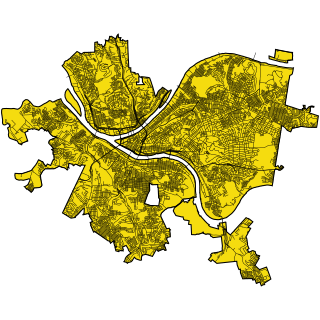Notes:Dinwiddie Street
Named for Governor Robert Dinwiddie
1892-08-10: Source:Signs-for-streets: "Dinwiddie is a name applied to that street formerly known as Shafer's lane, then Lippincott's lane. The name is in memory of Governor Dinwiddie, who ruled the territory of which this was a part, prior to the Revolution and known as Virginia. It was called Lippincott's lane until 12 years ago, that name being given because of Lippincott's big shovel and saw factory located where the Lockhart dwellings are now."
1893-02-15: Source:Harding: "Dinwiddie brings to mind the crusty but far-seeing Scotch Governor of Virginia, who first comprehended the value of the disputed land."
1911-02-16: Source:History-in-street-signs: "'Dinwiddie Street—Robert Dinwiddie, Governor of Virginia, 1690–1770.'"
1914-11-29: Source:Fleming-history-told: "On the side of the English we have a long list of commemorated names, but without system and regardless of association. Van Braam (the real Dutch spelling and the correct one); Gist and Dinwiddie afford in street appellations the best continuation of contemporaries and events and locally these streets are neighboring."
1922: Source:Fleming-history
- p. 204: "Close to the street bearing the name of doughty Governor Dinwiddie, whose acts began the struggle for the continent of North America, there are yet two streets with unmistakably French names, those of Coulon de Villiers and his slain brother, Jumonville."
- p. 303: "In the same locality as Van Braam street are Washington, Gist, Dinwiddie, Devillier's (another transposition), and Jumonville streets—all reminders of Washington's Campaign of 1754."
1923-11-30: Source:Miller, p. 26: "Dinwiddie, for the Scotch Governor of Virginia."
1936-09-26: Source:Street-names: "Dinwiddie street—for the Scotch governor of Virginia, who first realized the inroads the French were making in the Ohio valley and sent appeals for aid to England, troops to build a fort at the Ohio headwaters. The French arrived before his men had completed their fort, drove them out and built their own Fort Duquesne."
1944-02-12: Source:Love-titles: "Washington was on his way to Fort LeBoeuf, now Erie, to warn the French there not to try to come any farther south. He had been sent by Governor Dinwiddie of Virginia, for whom a street in the Uptown section is named."
1966-02-06: Source:Carlin: ". . . Dinwiddie for the governor of Virginia; . . ."
1967-03-30: Source:Delaney: "Dinwiddie Street—For the Colonial governor of Virginia who saw the inroads the French were making in the Ohio valley and appealed to England for troops to build a fort at the Ohio headwaters. The French arrived before the English completed their fort, forced them out and built their own Fort Duquesne."
2009: Source:Regan, p. 67: "Dinwiddie Street ¶ Named for Robert Dinwiddie (1692–1770), lieutenant governor of Virginia who dispatched Washington to Western Pennsylvania to address the French encroachment into the region."
Shoffer's Lane
1915-12-19: Source:Fleming-reisville: "Reisville was the settlement along the Fourth street road extending from Price's, at what is now Stevenson street, to Lippincott's Lane, now Dinwiddie street. ¶ . . . ¶ Christ Seitz and his sons Daniel and George, the Reises, Adam Weaver, John Andregg, 'Barney' Flanagan, 'Matt' McGinn and John Henry Miller were butchers also. Then there was John S. Shoffer, 'way out in Shoffers lane,' which was also called Lippencotts lane. Mr. Shoffer was also 'way out in the country' and 'on the edge of Lacyville.' ¶ . . . ¶ 'Sooks Run'—properly 'Sukes'—which came down the 'lane' and meandered along the base of Boyds Hill, formerly called Ayres Hill, entered the Monongahela at the present Panhandle Bridge. Its upper portion was precipitous. The 'lane' was a dirt wagon road through a ravine. ¶ The run is shown on all the old maps of Pittsburgh and flowed first on the north side of the Fourth street road, crossing to the other above Magee street. ¶ In 1863 the run was not sewered below Magee street and flowed through the Watson property between the Fourth street road, then Pennsylvania avenue, and the present Watson street. ¶ Sukes Run, coming from the highland about the present Central Park on Bedford avenue, was somewhat torrential after a big rain and this was an incentive for butchers to locate their slaughter houses along it, the run being thoroughly flushed after a rain."
